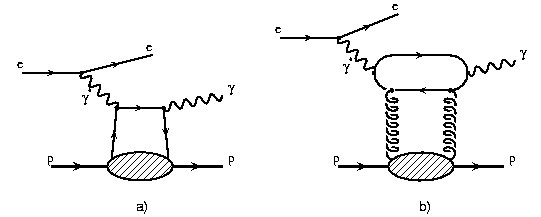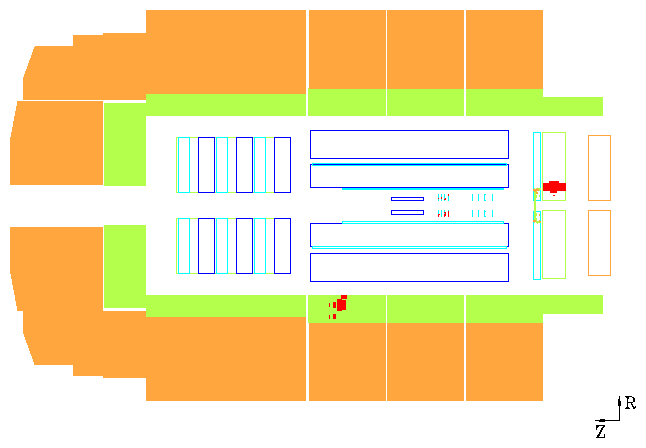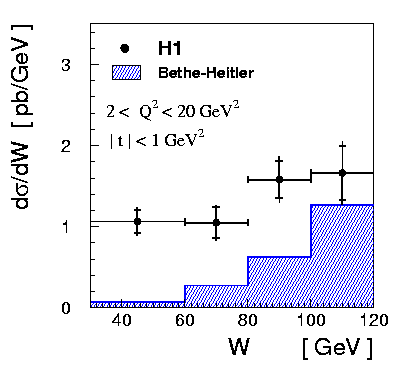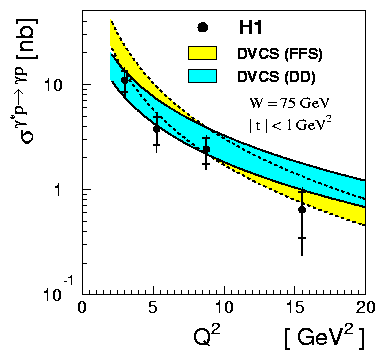Measurement of Deeply Virtual Compton Scattering at HERA
|
Electron-Proton Scattering
One of the main missions of the electron proton collider
HERA is the investigation of the structure of the proton. It is known that
the proton consists of quarks and gluons, the so called partons. In electron
proton collisions the incoming electron emits a photon which interacts
with a parton from the proton. One of the main results achieved was the
precise measurement of the so called parton density functions fi(x,Q2)
which denotes the probability to find a parton of type i with a certain
momentum fraction x at a resolution scale Q2 where 1/Q
is the wavelength of the incoming photon which probes the proton. At HERA
a large range in Q2 is available which enables us to study the
proton structure at large and small distances.
Deeply Virtual Compton Scattering (DVCS)
In a certain class of interactions, the so called diffractive
events, the photon interacts with more than one parton of the incoming
proton. This kind of events have already been observed in hadron-hadron
colliders three decades ago and nowadays it can be understood on the basis
of modern theories in terms of quarks and gluons. The large number of this
kind of events (~10%) was unexpected when HERA was switched on and initiated
a huge research activity.
The simplest model of diffraction which is the exchange
of two partons can be tested by studying the DVCS process which is shown
in the following figure.

In diagram a) a photon is emitted by the incoming electron which then interacts
with a quark originating from the incoming proton. The quark emits a photon
and enters the proton again. Thus the proton has the opportunity to stay
intact. In diagram b) the incoming photon interacts indirectly via a quark
loop with two gluons of the incoming proton. The real photon is also
emitted from the quark line.
The main goal of studying the DVCS process is to investigate the corellations
between the two exchanged partons measuring the so called skewed parton
distributions which are generalisations of the parton distributions. Presently
the knowledge of this distributions is almost zero apart from some theoretical
constraints.
Here thefirst measurement for the so far unknown cross section of the
DVCS process is presented.
The Measurement
In both reactions the signature consists of an electron, a photon and a
proton. In the following figure an event is shown which was collected by
the H1 detector. The photon is identified by an electromagnetic cluster
in the calorimeter in the central part of the detector. The tracking detectors
between the interaction point and the calorimeter show no signal of a charged
particle. The electron is recognised by a cluster in the electromagnetic
calorimeter in the backward region(right) of the H1 detector. The proton
is not measured. It leaves the detector through the beam pipe. All other
parts of the detector show no signal.

Background
The main task of this analysis is to control the background, i.e.
events originating from other processes which show the same signature in
the detector as DVCS events. At HERA another process is present which has
the same final state as DVCS. It is the so called Bethe-Heitler(BH) process.
A diagram of the BH process is given below. Due to its apparent simplicity
the probability for BH process is precisely known. An excess of events
over the BH prediction can thus be attributed to the DVCS process.

Results
In the diagram below we show one of the results of this measurement. The
differential ep cross section (roughly speaking: "The probability to find
such events") as a function of W which is the energy in the photon
proton center of mass system. The points show the results of the measurement,
the assigned error bars are due to the statistical precision and due to
systematic uncertainties. This process is very rare, therefore the statistical
uncertainty is large. In total we have observed 172 events of this type.
The systematic uncertainty is due to our limited knowledge of the detector
on certain physics processes. The blue histogram shows the contribution
which is predicted for the Bethe-Heitler process. The measured distribution
differs strongly from the predicted cross section for the BH process. This
difference is attributed to the DVCS process.

In order to extract the DVCS cross section the prediction for the BH
process has been subtracted which is well known. In the figure below
the cross section for the DVCS cross section is shown as a function
of the kinematic variable Q2. The data(black points) are compared
to theoretical predictions. In yellow the prediction by Frankfurt, Freund
and Strikman is shown, in blue the prediction by Donnachie and Dosch. Both
calculations exhibit a normalisation uncertainty which is indicated as
a band. It can be seen that within this normalisation uncertainty the theories
describe the measurement.






